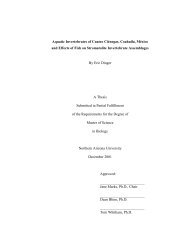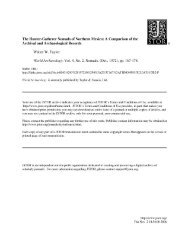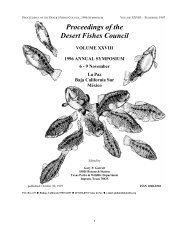Proceedings of the Desert Fishes Council 2000
Proceedings of the Desert Fishes Council 2000
Proceedings of the Desert Fishes Council 2000
Create successful ePaper yourself
Turn your PDF publications into a flip-book with our unique Google optimized e-Paper software.
PROCEEDINGS OF THE DESERT FISHES COUNCIL - VOLUME XXX1I (<strong>2000</strong> SYMPOSIUM) – PUBLISHED NOVEMBER 13, 2001<br />
numbers had slightly increased from <strong>the</strong> previous August. Population estimates ranged from 4,920/km to<br />
200/km. Spinedace were found in <strong>the</strong> upper four <strong>of</strong> six 25-meter permanent transects.<br />
During a survey in March-April <strong>2000</strong> at <strong>the</strong> Muddy River, 940 Moapa dace, Moapa coriacea, were counted.<br />
This is similar to numbers in <strong>the</strong> reaches surveyed in 1999. Muddy Spring, <strong>the</strong> main stem <strong>of</strong> <strong>the</strong> Muddy River,<br />
and Plummer Springs were not surveyed. The management focus on <strong>the</strong> Muddy River has been <strong>the</strong> eradication<br />
<strong>of</strong> blue tilapia. Rotenone treatments have been successful at <strong>the</strong> Apcar tributary and <strong>the</strong> refuge springs. A<br />
permanent barrier was constructed in July <strong>2000</strong> to prevent upstream movement <strong>of</strong> tilapia into <strong>the</strong>se treated<br />
segments. Virgin chub, Gila seminuda, Moapa speckled dace, Rhinichthys osculus moapae, and Moapa White<br />
River springfish, Crenichthys baileyi moapae, have also been negatively impacted by <strong>the</strong> tilapia.<br />
Virgin River native-fishes monitoring completed in Nevada by <strong>the</strong> recovery team in October and April found<br />
only four woundfin, Plagopterus argentissimus, and no Virgin chub. Studies using woundfin obtained from<br />
Dexter National Fish Hatchery and Technology Center continued in <strong>2000</strong>. In October 1999, a total <strong>of</strong> 9,275<br />
woundfin were released in Nevada reaches <strong>of</strong> <strong>the</strong> Virgin River just below <strong>the</strong> Arizona border. A portion <strong>of</strong> <strong>the</strong>se<br />
fish have remained in <strong>the</strong> system resulting in reproduction and recruitment.<br />
A program to repatriate Virgin spinedace, Lepidomeda mollispinis mollispinis, back into Nevada at Beaver<br />
Dam Wash has been ongoing for several years. Sampling in April and June <strong>2000</strong> again found adult spinedace<br />
but no recruitment.<br />
Bio/West Inc., supported by <strong>the</strong> Sou<strong>the</strong>rn Nevada Water Authority, continues to survey for razorback sucker,<br />
Xyrauchen texanus, at Lake Mead. At Lake Mohave, NDOW provided assistance in <strong>the</strong> collection <strong>of</strong> 91,000<br />
razorback sucker larvae. A portion <strong>of</strong> <strong>the</strong>se were reared at <strong>the</strong> Boulder City Golf Course ponds and <strong>the</strong> Veterans<br />
Park ponds in cooperation with <strong>the</strong> Bureau <strong>of</strong> Reclamation. In 1999, <strong>the</strong>se ponds provided a total <strong>of</strong> 7,500 fish<br />
for repatriation into Lake Mohave.<br />
NDOW and cooperating agencies continued to intensively survey <strong>the</strong> population status, habitat selectivity,<br />
movement patterns, and growth rates <strong>of</strong> Amargosa toad, Bufo nelsoni. To date, over 2,000 adults have been<br />
implanted with PIT tags at 11 survey sites. Recapture rates during <strong>the</strong> latest surveys were above 50 %. The<br />
objective <strong>of</strong> this project is to quantify <strong>the</strong> population <strong>of</strong> Amargosa toad in Oasis Valley by using mark-recapture<br />
monitoring, and to create a model for potentially suitable habitat.<br />
RESUMEN<br />
Manejo de peces nativos y anfibios en el sur de Nevada<br />
Los conteos del tamaño poblacional del cachorrito de Devils Hole, Cyprinodon diabolis, siguen indicando<br />
una tendencia decreciente. Las cifras recientes son: agosto 1999, 344; octubre 1999, 328; diciembre 1999, 288;<br />
febrero <strong>2000</strong>, 240; abril <strong>2000</strong>, 190; junio <strong>2000</strong>, 223; y agosto <strong>2000</strong>, 286. Desde su reactivación en 1998, el<br />
refugio de la Presa Hoover sigue funcionando adecuadamente. Los conteos para este sitio para diciembre 1999,<br />
febrero <strong>2000</strong>, mayo <strong>2000</strong> y julio <strong>2000</strong> fueron: 35, 38, 45, y 72, respectivamente.<br />
La División de Vida Silvestre de Nevada (NDOW, por sus siglas en inglés) junto con el Refugio Nacional de<br />
Vida Silvestre de Ash Meadows (AMNWR, por sus siglas en inglés) siguen removiendo las lobinas introducidas<br />
anteriormente a este refugio. La última fase del proceso consistirá en remover las lobinas del Reservorio Crystal.<br />
En 1999, personal del AMNWR y voluntarios removieron 12,470 peces, langostinos y anfibios no nativos. Un<br />
gran incendio que quemó casi 1,500 acres en la porción norte del refugio, eliminó grandes bosques de pino<br />
salado [Tamarix] y el remanente de la comunidad de flora nativa del lugar.<br />
Hacia finales de enero y principios de febrero de <strong>2000</strong> se efectuó la evaluación de invierno de carpa cola<br />
redonda de Paharanagat, Gila robusta jordani; se contaron 133 peces, 33 de los cuales eran juveniles. Esta cifra<br />
es similar a la de años anteriores también en invierno. En el censo de julio <strong>2000</strong> se encontraron 138 carpas (68<br />
juveniles). Esto sigue indicando un descenso importante de las estimaciones de verano en 1998 y 1999. En un<br />
estudio de junio de 1998 se estimaron 2,894 carpas (2,596 juveniles). En junio de 1999 se contaron solo 308<br />
carpas (132 juveniles).<br />
En junio de <strong>2000</strong> se hizo el monitoreo del pez de manantial Hiko del Río White, Crenichthys baileyi<br />
grandis, dentro del Valle Pahranagat en los manantiales Crystal y Hiko. En el Manantial Hiko, mediante<br />
marcado-recaptura, se estimaron 6,277 peces adultos de esta subespecie. En ese sitio estos constituyeron casi el<br />
55% de todos los peces. El resto de las especies encontradas aquí fueron topote del Atlántico, guayacón<br />
37



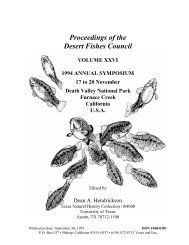
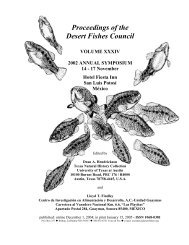
![Part 2 [419KK] - Desert Fishes Council](https://img.yumpu.com/14712282/1/190x245/part-2-419kk-desert-fishes-council.jpg?quality=85)

